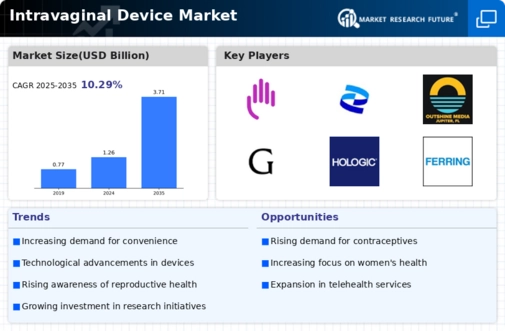Growing Focus on Women's Health
The Intravaginal Device Market is witnessing a heightened focus on women's health, which is significantly influencing market dynamics. As healthcare systems increasingly prioritize gender-specific health issues, there is a corresponding rise in the development and adoption of intravaginal devices tailored to women's needs. This focus encompasses a range of applications, including contraception, hormone therapy, and treatment of various gynecological conditions. Recent data suggests that the women's health segment is expected to account for a substantial share of the intravaginal device market, with projections indicating a growth rate of around 7% annually. This trend reflects a broader societal shift towards recognizing and addressing women's health issues, thereby creating opportunities for innovation and expansion within the intravaginal device market.
Increased Regulatory Support and Approval
The Intravaginal Device Market is benefiting from increased regulatory support and streamlined approval processes. Regulatory bodies are recognizing the importance of intravaginal devices in addressing various health issues, leading to more favorable conditions for market entry. Recent changes in regulatory frameworks have facilitated faster approval times for new products, encouraging innovation and competition within the market. This regulatory support is crucial for manufacturers, as it reduces barriers to entry and fosters a more dynamic market environment. As a result, the intravaginal device market is likely to see an influx of new products and technologies, further enhancing the variety and availability of options for consumers.
Rising Awareness of Preventive Healthcare
The Intravaginal Device Market is experiencing a surge in awareness regarding preventive healthcare measures. As individuals become more informed about the benefits of preventive health strategies, there is a growing inclination towards the use of intravaginal devices for various health management purposes. This trend is particularly evident in the context of reproductive health, where preventive measures can significantly impact overall well-being. Market data suggests that the preventive healthcare segment is poised for substantial growth, with projections indicating an increase of approximately 5% annually. This rising awareness is likely to drive demand for intravaginal devices, as consumers seek proactive solutions to manage their health effectively.
Rising Demand for Contraceptive Solutions
The Intravaginal Device Market is experiencing a notable increase in demand for contraceptive solutions. This trend is driven by a growing awareness of reproductive health and family planning. As more individuals seek effective and convenient methods of contraception, intravaginal devices are becoming a preferred choice. According to recent estimates, the contraceptive segment within the intravaginal device market is projected to grow at a compound annual growth rate of approximately 6.5% over the next five years. This growth is indicative of a broader shift towards proactive reproductive health management, where individuals prioritize their choices and seek reliable solutions. The rise in demand for contraceptive solutions is likely to propel innovation and development within the intravaginal device market, leading to enhanced product offerings and improved user experiences.
Technological Innovations in Device Design
The Intravaginal Device Market is significantly influenced by ongoing technological innovations in device design. Advances in materials science and engineering are leading to the development of more effective and user-friendly intravaginal devices. Innovations such as bio-compatible materials, smart drug delivery systems, and enhanced comfort features are becoming increasingly prevalent. These advancements not only improve the efficacy of the devices but also enhance user compliance and satisfaction. Market analysis indicates that the segment of technologically advanced intravaginal devices is expected to grow at a rate of approximately 8% over the next few years. This growth is indicative of a broader trend towards integrating technology into healthcare solutions, thereby transforming the landscape of the intravaginal device market.


















Leave a Comment